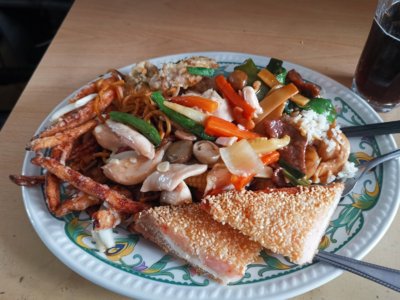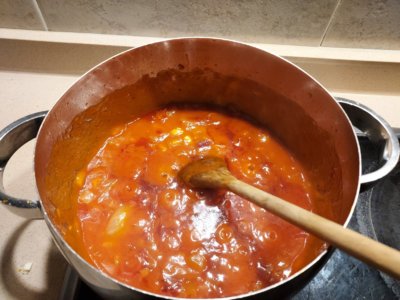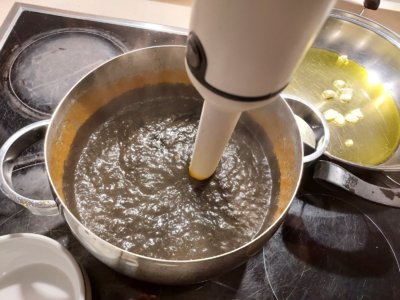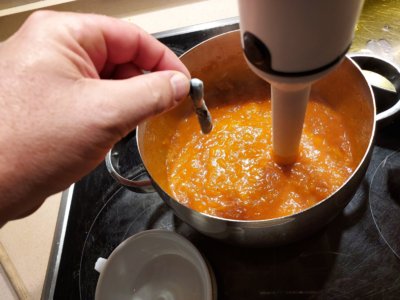Had galacia octopus in San Sebastián. Never had it like that since. One of my top five culinary experiences in my life. Have ordered it a number of places outside of Spain but never close.
You are using an out of date browser. It may not display this or other websites correctly.
You should upgrade or use an alternative browser.
You should upgrade or use an alternative browser.
your meal today...
- Thread starter deQuincey
- Start date
Had galacia octopus in San Sebastián. Never had it like that since. One of my top five culinary experiences in my life. Have ordered it a number of places outside of Spain but never close.
i can understand what you said,..local food travels bad, maybe you do not have the ingredients, maybe, the cook ,...
was that octopus and steamed potatoes ?
i work half of the week at our premises in donostia (san sebastian)
this is to say that i know the place pretty well, food is fantastic all around the world but maybe here it is a plus, a bit more, attention to food is extraordinary, here almost every place offers good food, not only those three michelin star restaurants, but little bars, and small taberns
but real octopus like “pulpo a la gallega” is there in galicia, in a plastic tent, by side of a river, where a popular celebration offers this as humble and extraordinary as those things that you have been preparing for generations, they do not even look at the clock while cooking, you and me will need a countdown, they simply look at the colours, textures,...
let me show you an example of a humble meal that has been rewarded with the surname of the country that cooks it massively and in various forms
ingredients, (in order of appearance) potatoes, sunflower oil, salt, eggs, olive oil, and that is all
the process is simple but sensitive, heat, and time make it perfect or ruin it all
sunflower oil is needed to fry the potatoes, a lot of that oil is needed, olive oil is to make the omelette, only a drop is needed




the dinner is completed with natural homemade country bread, and bellota iberico ham


ingredients, (in order of appearance) potatoes, sunflower oil, salt, eggs, olive oil, and that is all
the process is simple but sensitive, heat, and time make it perfect or ruin it all
sunflower oil is needed to fry the potatoes, a lot of that oil is needed, olive oil is to make the omelette, only a drop is needed
the dinner is completed with natural homemade country bread, and bellota iberico ham
Its 5:52 pm here, and I'm getting hungry...that looks simply wonderful. Can't easily get the imberico jamon, but I can improvise. Love to have this recipe...I am the egg man. Great pictures as always.
HonaloochieBoogie
Well-Known Member
Now that I’m retired, I do a lot of the cooking. But tonight I just finished devouring a favorite vegetarian dish (though I’m a confirmed omnivore) prepared by my wife, Margaret. It’s the ratatouille recipe that is featured in the Disney movie, although the recipe is actually called Confit Byaldi by Thomas Keller, who came up with it. Most of the ingredients were grown in our garden. That’s as close as I can come to livin’ off the land.

Now that I’m retired, I do a lot of the cooking. But tonight I just finished devouring a favorite vegetarian dish (though I’m a confirmed omnivore) prepared by my wife, Margaret. It’s the ratatouille recipe that is featured in the Disney movie, although the recipe is actually called Confit Byaldi by Thomas Keller, who came up with it. Most of the ingredients were grown in our garden. That’s as close as I can come to livin’ off the land. View attachment 121273
wow, that looks delicious
and it seems to be a lot of work...
HonaloochieBoogie
Well-Known Member
I’m fond of the Katie Button version of this dish, which is popular at Curate in Asheville NC. As you say, it requires a lot of oil, but it’s worth it.let me show you an example of a humble meal that has been rewarded with the surname of the country that cooks it massively and in various forms
ingredients, (in order of appearance) potatoes, sunflower oil, salt, eggs, olive oil, and that is all
the process is simple but sensitive, heat, and time make it perfect or ruin it all
sunflower oil is needed to fry the potatoes, a lot of that oil is needed, olive oil is to make the omelette, only a drop is needed
View attachment 121128
View attachment 121127
View attachment 121130
View attachment 121126
the dinner is completed with natural homemade country bread, and bellota iberico ham
View attachment 121131
View attachment 121129
my experience with fire,...
there is a basic ingredient when cooking using the grill, fire,
and there are many different choices as what to use, and the process and the moment
fish is different than meat, fire for fish is not as strong as that one for meat
i use vegetal coal from dense wood, prepare a pile

set fire to the pile and let stay for 20 minutes alone, unmolested

now i open the front bar and let the coal breath a bit, another 10 minutes,

and it is ready

some people take more time and start with wood, other use pressed materials, ...what is your choice ?
there is a basic ingredient when cooking using the grill, fire,
and there are many different choices as what to use, and the process and the moment
fish is different than meat, fire for fish is not as strong as that one for meat
i use vegetal coal from dense wood, prepare a pile
set fire to the pile and let stay for 20 minutes alone, unmolested
now i open the front bar and let the coal breath a bit, another 10 minutes,
and it is ready
some people take more time and start with wood, other use pressed materials, ...what is your choice ?
and one of the most recognisable recipes from basque country, “txipiroiek bere tintan”,
obviously we are talking about calamar, squid, txipiroia in basque
but most important is the base, and that is onion,...and garlic, and olive oil, we get all vegetables locally, fish too, i try to buy only what is available for the season, we just finished anchovies, and we will start white tuna very soon,



another pan with olive oil for the squid

and now squid clean and preparation,






and the ink, remove carefully the whole bag



finally add it to the squid and keep it for 30minutes at medium fire, 30 minutes needed for 5mm thick squid flesh, if they are thinner reduce time accordingly

obviously we are talking about calamar, squid, txipiroia in basque
but most important is the base, and that is onion,...and garlic, and olive oil, we get all vegetables locally, fish too, i try to buy only what is available for the season, we just finished anchovies, and we will start white tuna very soon,
another pan with olive oil for the squid
and now squid clean and preparation,
and the ink, remove carefully the whole bag
finally add it to the squid and keep it for 30minutes at medium fire, 30 minutes needed for 5mm thick squid flesh, if they are thinner reduce time accordingly
Attachments
Last edited:
Freakin love this!my experience with fire,...
there is a basic ingredient when cooking using the grill, fire,
and there are many different choices as what to use, and the process and the moment
fish is different than meat, fire for fish is not as strong as that one for meat
i use vegetal coal from dense wood, prepare a pile
View attachment 121521
set fire to the pile and let stay for 20 minutes alone, unmolested
View attachment 121522
now i open the front bar and let the coal breath a bit, another 10 minutes,
View attachment 121520
and it is ready
View attachment 121523
some people take more time and start with wood, other use pressed materials, ...what is your choice ?
DeQ your food prep is as meticulous as your maintenance - how am I not surprised 
DeQ your food prep is as meticulous as your maintenance - how am I not surprised
i absolutely agree, food is as serious as maintenance ;-)
Eating well is the ultimate revenge.
‘Murcia!

Rex Kapriellian
Well-Known Member
Octopus has become one of my favorite lately.Whenever I get a chance, I like to grill an Octopus. Season with lemon, oregano, olive oil and salt. Anyone interested in how to cook it let me know.
interesting article on cod fish and basques, Vikings, and rest of Europeans, including British and French, …in two parts due to length…
PART 1
Cod
A Biography of the Fish That Changed the World
By MARK KURLANSKY
Walker and Company
 Read the Review
Read the Review
The Race to Codlandia
This Basque folktale shows not only the Basque attachment to their orphan language, indecipherable to the rest of the world, but also their tie to the Atlantic cod, Gadus morhua, a fish that has never been found in Basque or even Spanish waters.
The Basques are enigmatic. They have lived in what is now the northwest corner of Spain and a nick of the French southwest for longer than history records, and not only is the origin of their language unknown, but the origin of the people themselves remains a mystery also. According to one theory, these rosy-checked, dark-haired, long-nosed people were the original Iberians, driven by invaders to this mountainous corner between the Pyrenees, the Cantabrian Sierra, and the Bay of Biscay. Or they may be indigenous to this area.
They graze sheep on impossibly steep, green slopes of mountains that are thrilling in their rare, rugged beauty. They sing their own songs and write their own literature in their own language, Euskera. Possibly Europe's oldest living language, Euskera is one of only four European languages--along with Estonian, Finnish, and Hungarian--not in the Indo-European family. They also have their own sports, most notably jai alai, and even their own hat, the Basque beret, which is bigger than any other beret.
Though their lands currently reside in three provinces of France and four of Spain, Basques have always insisted that they have a country, and they call it Euskadi. All the powerful peoples around them--the Celts and Romans, the royal houses of Aquitaine, Navarra, Aragon, and Castile; later Spanish and French monarchies, dictatorships, and republics--have tried to subdue and assimilate them, and all have failed. In the 1960s, at a time when their ancient language was only whispered, having been outlawed by the dictator Francisco Franco, they secretly modernized it to broaden its usage, and today, with only 800,000 Basque speakers in the world, almost 1,000 titles a year are published in Euskera, nearly a third by Basque writers and the rest translations.
"Nire aitaren etxea / defendituko dut. / Otsoen kontra" (I will defend / the house of my father. / Against the wolves) are the opening lines of a famous poem in modern Euskera by Gabriel Aresti, one of the fathers of the modernized tongue. Basques have been able to maintain this stubborn independence, despite repression and wars, because they have managed to preserve a strong economy throughout the centuries. Not only are Basques shepherds, but they are also a seafaring people, noted for their successes in commerce. During the Middle Ages, when Europeans ate great quantities of whale meat, the Basques traveled to distant unknown waters and brought back whale. They were able to travel such distances because they had found huge schools of cod and salted their catch, giving them a nutritious food supply that would not spoil on long voyages.
Basques were not the first to cure cod. Centuries earlier, the Vikings had traveled from Norway to Iceland to Greenland to Canada, and it is not a coincidence that this is the exact range of the Atlantic cod. In the tenth century, Thorwald and his wayward son, Eirik the Red, having been thrown out of Norway for murder, traveled to Iceland, where they killed more people and were again expelled. About the year 985, they put to sea from the black lava shore of Iceland with a small crew on a little open ship. Even in midsummer, when the days are almost without nightfall, the sea there is gray and kicks up whitecaps. But with sails and oars, the small band made it to a land of glaciers and rocks, where the water was treacherous with icebergs that glowed robin's-egg blue. In the spring and summer, chunks broke off the glaciers, crashed into the sea with a sound like thunder that echoed in the fiords, and sent out huge waves. Eirik, hoping to colonize this land, tried to enhance its appeal by naming it Greenland.
Almost 1,000 years later, New England whalers would sing: "Oh, Greenland is a barren place / a place that bears no green / Where there's ice and snow / and the whale fishes blow / But daylight's seldom seen."
Eirik colonized this inhospitable land and then tried to push on to new discoveries. But he injured his foot and had to be left behind. His son, Leifur, later known as Leif Eiriksson, sailed on to a place he called Stoneland, which was probably the rocky, barren Labrador coast. "I saw not one cartload of earth, though I landed many places," Jacques Cartier would write of this coast six centuries later. From there, Leif's men turned south to "Woodland" and then "Vineland." The identity of these places is not certain. Woodland could have been Newfoundland, Nova Scotia, or Maine, all three of which are wooded. But in Vineland they found wild grapes, which no one else has discovered in any of these places.
The remains of a Viking camp have been found in Newfoundland. It is perhaps in that gentler land that the Vikings were greeted by inhabitants they found so violent and hostile that they deemed settlement impossible, a striking assessment to come from a people who had been regularly banished for the habit of murdering people. More than 500 years later the Beothuk tribe of Newfoundland would prevent John Cabot from exploring beyond crossbow range of his ship. The Beothuk apparently did not misjudge Europeans, since soon after Cabot, they were enslaved by the Portuguese, driven inland, hunted by the French and English, and exterminated in a matter of decades.
How did the Vikings survive in greenless Greenland and earthless Stoneland? How did they have enough provisions to push on to Woodland and Vineland, where they dared not go inland to gather food, and yet they still had enough food to get back? What did these Norsemen eat on the five expeditions to America between 985 and 1011 that have been recorded in the Icelandic sagas? They were able to travel to all these distant, barren shores because they had learned to preserve codfish by hanging it in the frosty winter air until it lost four-fifths of its weight and became a durable woodlike plank. They could break off pieces and chew them, eating it like hardtack. Even earlier than Eirik's day, in the ninth century, Norsemen had already established plants for processing dried cod in Iceland and Norway and were trading the surplus in northern Europe.
PART 1
Cod
A Biography of the Fish That Changed the World
By MARK KURLANSKY
Walker and Company

The Race to Codlandia
- He said it must be Friday, the day he could not sell anything except servings of a fish known in Castile as pollock or in Andalusia as salt cod.
--Miguel de Cervantes,
Don Quixote, 1605-1616
This Basque folktale shows not only the Basque attachment to their orphan language, indecipherable to the rest of the world, but also their tie to the Atlantic cod, Gadus morhua, a fish that has never been found in Basque or even Spanish waters.
The Basques are enigmatic. They have lived in what is now the northwest corner of Spain and a nick of the French southwest for longer than history records, and not only is the origin of their language unknown, but the origin of the people themselves remains a mystery also. According to one theory, these rosy-checked, dark-haired, long-nosed people were the original Iberians, driven by invaders to this mountainous corner between the Pyrenees, the Cantabrian Sierra, and the Bay of Biscay. Or they may be indigenous to this area.
They graze sheep on impossibly steep, green slopes of mountains that are thrilling in their rare, rugged beauty. They sing their own songs and write their own literature in their own language, Euskera. Possibly Europe's oldest living language, Euskera is one of only four European languages--along with Estonian, Finnish, and Hungarian--not in the Indo-European family. They also have their own sports, most notably jai alai, and even their own hat, the Basque beret, which is bigger than any other beret.
Though their lands currently reside in three provinces of France and four of Spain, Basques have always insisted that they have a country, and they call it Euskadi. All the powerful peoples around them--the Celts and Romans, the royal houses of Aquitaine, Navarra, Aragon, and Castile; later Spanish and French monarchies, dictatorships, and republics--have tried to subdue and assimilate them, and all have failed. In the 1960s, at a time when their ancient language was only whispered, having been outlawed by the dictator Francisco Franco, they secretly modernized it to broaden its usage, and today, with only 800,000 Basque speakers in the world, almost 1,000 titles a year are published in Euskera, nearly a third by Basque writers and the rest translations.
"Nire aitaren etxea / defendituko dut. / Otsoen kontra" (I will defend / the house of my father. / Against the wolves) are the opening lines of a famous poem in modern Euskera by Gabriel Aresti, one of the fathers of the modernized tongue. Basques have been able to maintain this stubborn independence, despite repression and wars, because they have managed to preserve a strong economy throughout the centuries. Not only are Basques shepherds, but they are also a seafaring people, noted for their successes in commerce. During the Middle Ages, when Europeans ate great quantities of whale meat, the Basques traveled to distant unknown waters and brought back whale. They were able to travel such distances because they had found huge schools of cod and salted their catch, giving them a nutritious food supply that would not spoil on long voyages.
Basques were not the first to cure cod. Centuries earlier, the Vikings had traveled from Norway to Iceland to Greenland to Canada, and it is not a coincidence that this is the exact range of the Atlantic cod. In the tenth century, Thorwald and his wayward son, Eirik the Red, having been thrown out of Norway for murder, traveled to Iceland, where they killed more people and were again expelled. About the year 985, they put to sea from the black lava shore of Iceland with a small crew on a little open ship. Even in midsummer, when the days are almost without nightfall, the sea there is gray and kicks up whitecaps. But with sails and oars, the small band made it to a land of glaciers and rocks, where the water was treacherous with icebergs that glowed robin's-egg blue. In the spring and summer, chunks broke off the glaciers, crashed into the sea with a sound like thunder that echoed in the fiords, and sent out huge waves. Eirik, hoping to colonize this land, tried to enhance its appeal by naming it Greenland.
Almost 1,000 years later, New England whalers would sing: "Oh, Greenland is a barren place / a place that bears no green / Where there's ice and snow / and the whale fishes blow / But daylight's seldom seen."
Eirik colonized this inhospitable land and then tried to push on to new discoveries. But he injured his foot and had to be left behind. His son, Leifur, later known as Leif Eiriksson, sailed on to a place he called Stoneland, which was probably the rocky, barren Labrador coast. "I saw not one cartload of earth, though I landed many places," Jacques Cartier would write of this coast six centuries later. From there, Leif's men turned south to "Woodland" and then "Vineland." The identity of these places is not certain. Woodland could have been Newfoundland, Nova Scotia, or Maine, all three of which are wooded. But in Vineland they found wild grapes, which no one else has discovered in any of these places.
The remains of a Viking camp have been found in Newfoundland. It is perhaps in that gentler land that the Vikings were greeted by inhabitants they found so violent and hostile that they deemed settlement impossible, a striking assessment to come from a people who had been regularly banished for the habit of murdering people. More than 500 years later the Beothuk tribe of Newfoundland would prevent John Cabot from exploring beyond crossbow range of his ship. The Beothuk apparently did not misjudge Europeans, since soon after Cabot, they were enslaved by the Portuguese, driven inland, hunted by the French and English, and exterminated in a matter of decades.
How did the Vikings survive in greenless Greenland and earthless Stoneland? How did they have enough provisions to push on to Woodland and Vineland, where they dared not go inland to gather food, and yet they still had enough food to get back? What did these Norsemen eat on the five expeditions to America between 985 and 1011 that have been recorded in the Icelandic sagas? They were able to travel to all these distant, barren shores because they had learned to preserve codfish by hanging it in the frosty winter air until it lost four-fifths of its weight and became a durable woodlike plank. They could break off pieces and chew them, eating it like hardtack. Even earlier than Eirik's day, in the ninth century, Norsemen had already established plants for processing dried cod in Iceland and Norway and were trading the surplus in northern Europe.













